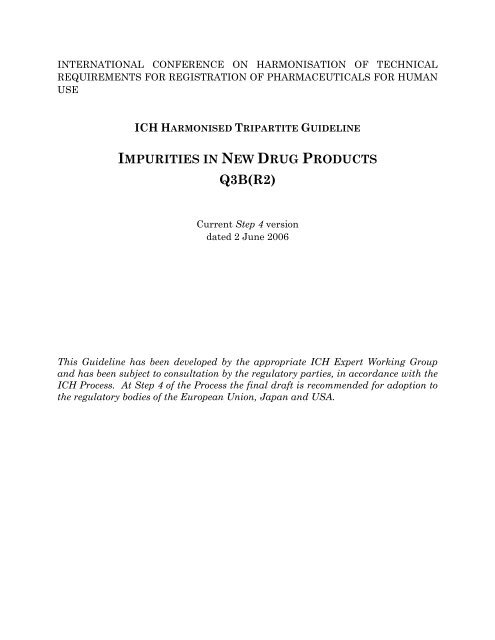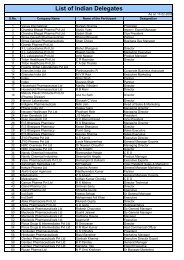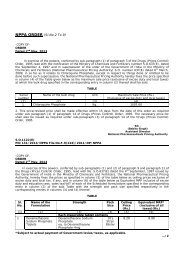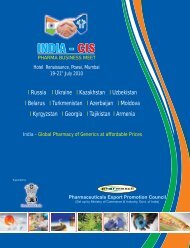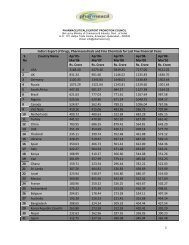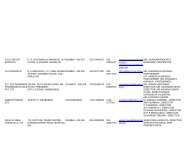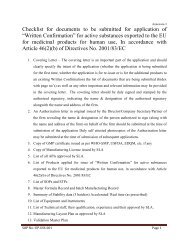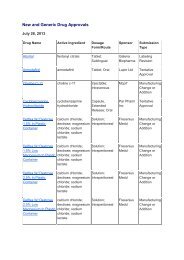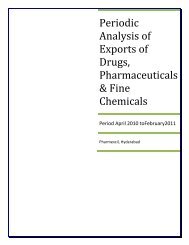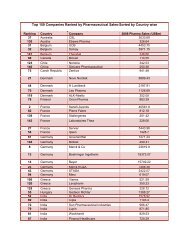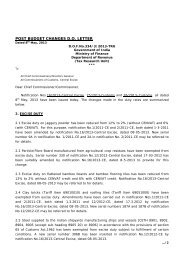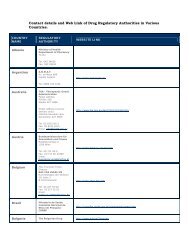impurities in new drug products
impurities in new drug products
impurities in new drug products
You also want an ePaper? Increase the reach of your titles
YUMPU automatically turns print PDFs into web optimized ePapers that Google loves.
INTERNATIONAL CONFERENCE ON HARMONISATION OF TECHNICALREQUIREMENTS FOR REGISTRATION OF PHARMACEUTICALS FOR HUMANUSEICH HARMONISED TRIPARTITE GUIDELINEIMPURITIES IN NEW DRUG PRODUCTSQ3B(R2)Current Step 4 versiondated 2 June 2006This Guidel<strong>in</strong>e has been developed by the appropriate ICH Expert Work<strong>in</strong>g Groupand has been subject to consultation by the regulatory parties, <strong>in</strong> accordance with theICH Process. At Step 4 of the Process the f<strong>in</strong>al draft is recommended for adoption tothe regulatory bodies of the European Union, Japan and USA.
Q3B(R2)Document HistoryFirstCodificationHistoryDateNewCodificationNovember2005Q3BApproval by the Steer<strong>in</strong>g Committee under Step 2 andrelease for public consultation.29November1995Q3BQ3BApproval by the Steer<strong>in</strong>g Committee under Step 4 andrecommendation for adoption to the three ICH regulatorybodies.6November1996Q3BQ3B(R)Approval by the Steer<strong>in</strong>g Committee of the first Revisionunder Step 2 and release for public consultation.7October1999Q3B(R1)Q3B(R)Approval by the Steer<strong>in</strong>g Committee of the first Revisionunder Step 4 and recommendation for adoption to the threeICH regulatory bodies.5February2003Q3B(R1)Current Step 4 versionQ3B(R2)Approval by the Steer<strong>in</strong>g Committee of the revision of theAttachment 2 directly under Step 4 without further publicconsultation.2 June2006Q3B(R2)
IMPURITIES IN NEW DRUG PRODUCTSICH Harmonised Tripartite Guidel<strong>in</strong>eHav<strong>in</strong>g reached Step 4 of the ICH Process at the ICH Steer<strong>in</strong>g Committee meet<strong>in</strong>gon 5 February 2003, this guidel<strong>in</strong>e is recommended foradoption to the three regulatory parties to ICHAttachment 2 has been revised on 6 June 2006.TABLE OF CONTENTS1. INTRODUCTION ........................................................................................ 11.1 Objective of the guidel<strong>in</strong>e .......................................................................................... 11.2 Background ................................................................................................................. 11.3 Scope of the guidel<strong>in</strong>e ................................................................................................ 12. RATIONALE FOR THE REPORTING AND CONTROL OFDEGRADATION PRODUCTS ................................................................... 13. ANALYTICAL PROCEDURES.................................................................. 24. REPORTING DEGRADATION PRODUCTS CONTENT OFBATCHES ..................................................................................................... 25. LISTING OF DEGRADATION PRODUCTS IN SPECIFICATIONS .. 36. QUALIFICATION OF DEGRADATION PRODUCTS ........................... 47. GLOSSARY ................................................................................................... 6Attachment 1: Thresholds for Degradation Products <strong>in</strong> New Drug Products ..................... 7Attachment 2: Illustration of Report<strong>in</strong>g Degradation Product Results for Identificationand Qualification <strong>in</strong> an Application ........................................................................................ 9Attachment 3: Decision Tree for Identification and Qualification of a DegradationProduct ................................................................................................................................... 11i
IMPURITIES IN NEW DRUG PRODUCTS1. INTRODUCTION1.1 Objective of the guidel<strong>in</strong>eThis document provides guidance for registration applications on the content andqualification of <strong>impurities</strong> <strong>in</strong> <strong>new</strong> <strong>drug</strong> <strong>products</strong> produced from chemicallysynthesised <strong>new</strong> <strong>drug</strong> substances not previously registered <strong>in</strong> a region or memberstate.1.2 BackgroundThis guidel<strong>in</strong>e is complementary to the ICH Q3A(R) guidel<strong>in</strong>e “Impurities <strong>in</strong> NewDrug Substances”, which should be consulted for basic pr<strong>in</strong>ciples. The ICH Q3Cguidel<strong>in</strong>e “Residual Solvents” should also be consulted, if appropriate.1.3 Scope of the guidel<strong>in</strong>eThis guidel<strong>in</strong>e addresses only those <strong>impurities</strong> <strong>in</strong> <strong>new</strong> <strong>drug</strong> <strong>products</strong> classified asdegradation <strong>products</strong> of the <strong>drug</strong> substance or reaction <strong>products</strong> of the <strong>drug</strong> substancewith an excipient and/or immediate conta<strong>in</strong>er closure system (collectively referred toas “degradation <strong>products</strong>” <strong>in</strong> this guidel<strong>in</strong>e). Generally, <strong>impurities</strong> present <strong>in</strong> the <strong>new</strong><strong>drug</strong> substance need not be monitored or specified <strong>in</strong> the <strong>new</strong> <strong>drug</strong> product unlessthey are also degradation <strong>products</strong> (see ICH Q6A guidel<strong>in</strong>e on specifications).Impurities aris<strong>in</strong>g from excipients present <strong>in</strong> the <strong>new</strong> <strong>drug</strong> product or extracted orleached from the conta<strong>in</strong>er closure system are not covered by this guidel<strong>in</strong>e. Thisguidel<strong>in</strong>e also does not apply to <strong>new</strong> <strong>drug</strong> <strong>products</strong> used dur<strong>in</strong>g the cl<strong>in</strong>ical researchstages of development. The follow<strong>in</strong>g types of <strong>products</strong> are not covered <strong>in</strong> thisguidel<strong>in</strong>e: biological/biotechnological <strong>products</strong>, peptides, oligonucleotides,radiopharmaceuticals, fermentation <strong>products</strong> and semi-synthetic <strong>products</strong> derivedtherefrom, herbal <strong>products</strong>, and crude <strong>products</strong> of animal or plant orig<strong>in</strong>. Alsoexcluded from this document are: (1) extraneous contam<strong>in</strong>ants that should not occur<strong>in</strong> <strong>new</strong> <strong>drug</strong> <strong>products</strong> and are more appropriately addressed as good manufactur<strong>in</strong>gpractice (GMP) issues, (2) polymorphic forms, and (3) enantiomeric <strong>impurities</strong>.2. RATIONALE FOR THE REPORTING AND CONTROL OFDEGRADATION PRODUCTSThe applicant should summarise the degradation <strong>products</strong> observed dur<strong>in</strong>gmanufacture and/or stability studies of the <strong>new</strong> <strong>drug</strong> product. This summary shouldbe based on sound scientific appraisal of potential degradation pathways <strong>in</strong> the <strong>new</strong><strong>drug</strong> product and <strong>impurities</strong> aris<strong>in</strong>g from the <strong>in</strong>teraction with excipients and/or theimmediate conta<strong>in</strong>er closure system. In addition, the applicant should summarise anylaboratory studies conducted to detect degradation <strong>products</strong> <strong>in</strong> the <strong>new</strong> <strong>drug</strong> product.This summary should also <strong>in</strong>clude test results of batches manufactured dur<strong>in</strong>g thedevelopment process and batches representative of the proposed commercial process.A rationale should be provided for exclusion of those <strong>impurities</strong> that are notdegradation <strong>products</strong> (e.g., process <strong>impurities</strong> from the <strong>drug</strong> substance and <strong>impurities</strong>aris<strong>in</strong>g from excipients). The impurity profiles of the batches representative of theproposed commercial process should be compared with the profiles of batches used <strong>in</strong>development and any differences discussed.Any degradation product observed <strong>in</strong> stability studies conducted at the recommendedstorage condition should be identified when present at a level greater than (>) the1
Impurities <strong>in</strong> New Drug Productsidentification thresholds given <strong>in</strong> Attachment 1. When identification of a degradationproduct is not feasible, a summary of the laboratory studies demonstrat<strong>in</strong>g theunsuccessful efforts to identify it should be <strong>in</strong>cluded <strong>in</strong> the registration application.Degradation <strong>products</strong> present at a level of not more than (≤) the identificationthreshold generally would not need to be identified. However, analytical proceduresshould be developed for those degradation <strong>products</strong> that are suspected to be unusuallypotent, produc<strong>in</strong>g toxic or significant pharmacological effects at levels not more than(≤) the identification threshold. In unusual circumstances, technical factors (e.g.,manufactur<strong>in</strong>g capability, a low <strong>drug</strong> substance to excipient ratio, or the use ofexcipients that are crude <strong>products</strong> of animal or plant orig<strong>in</strong>) can be considered as partof the justification for selection of alternative thresholds based upon manufactur<strong>in</strong>gexperience with the proposed commercial process.3. ANALYTICAL PROCEDURESThe registration application should <strong>in</strong>clude documented evidence that the analyticalprocedures have been validated and are suitable for the detection and quantitation ofdegradation <strong>products</strong> (see ICH Q2A and Q2B guidel<strong>in</strong>es on analytical validation). Inparticular, analytical procedures should be validated to demonstrate specificity for thespecified and unspecified degradation <strong>products</strong>. As appropriate, this validation should<strong>in</strong>clude samples stored under relevant stress conditions: light, heat, humidity,acid/base hydrolysis, and oxidation. When an analytical procedure reveals thepresence of other peaks <strong>in</strong> addition to those of the degradation <strong>products</strong> (e.g., the <strong>drug</strong>substance, <strong>impurities</strong> aris<strong>in</strong>g from the synthesis of the <strong>drug</strong> substance, excipients and<strong>impurities</strong> aris<strong>in</strong>g from the excipients), these peaks should be labeled <strong>in</strong> thechromatograms and their orig<strong>in</strong>(s) discussed <strong>in</strong> the validation documentation.The quantitation limit for the analytical procedure should be not more than (≤) thereport<strong>in</strong>g threshold.Degradation product levels can be measured by a variety of techniques, <strong>in</strong>clud<strong>in</strong>gthose that compare an analytical response for a degradation product to that of anappropriate reference standard or to the response of the <strong>new</strong> <strong>drug</strong> substance itself.Reference standards used <strong>in</strong> the analytical procedures for control of degradation<strong>products</strong> should be evaluated and characterised accord<strong>in</strong>g to their <strong>in</strong>tended uses. The<strong>drug</strong> substance can be used to estimate the levels of degradation <strong>products</strong>. In caseswhere the response factors are not close, this practice can still be used if a correctionfactor is applied or the degradation <strong>products</strong> are, <strong>in</strong> fact, be<strong>in</strong>g overestimated.Acceptance criteria and analytical procedures, used to estimate identified orunidentified degradation <strong>products</strong>, are often based on analytical assumptions (e.g.,equivalent detector response). These assumptions should be discussed <strong>in</strong> theregistration application.Differences between the analytical procedures used dur<strong>in</strong>g development and thoseproposed for the commercial product should also be discussed.4. REPORTING DEGRADATION PRODUCTS CONTENT OF BATCHESAnalytical results should be provided <strong>in</strong> the registration application for all relevantbatches of the <strong>new</strong> <strong>drug</strong> product used for cl<strong>in</strong>ical, safety, and stability test<strong>in</strong>g, as wellas batches that are representative of the proposed commercial process. Quantitativeresults should be presented numerically, and not <strong>in</strong> general terms such as “complies”,“meets limit” etc. Any degradation product at a level greater than (>) the report<strong>in</strong>g2
Impurities <strong>in</strong> New Drug Productsthreshold (see Attachment 1), and total degradation <strong>products</strong> observed <strong>in</strong> the relevantbatches of the <strong>new</strong> <strong>drug</strong> product, should be reported with the analytical procedures<strong>in</strong>dicated. Below 1.0%, the results should be reported to the number of decimal places(e.g., 0.06%) <strong>in</strong> the applicable report<strong>in</strong>g threshold; at and above 1.0%, the resultsshould be reported to one decimal place (e.g., 1.3%). Results should be rounded us<strong>in</strong>gconventional rules (see Attachment 2). A tabulation (e.g., spreadsheet) of the data isrecommended. Degradation <strong>products</strong> should be designated by code number or by anappropriate descriptor, e.g., retention time. If a higher report<strong>in</strong>g threshold isproposed, it should be fully justified. All degradation <strong>products</strong> at a level greater than(>) the report<strong>in</strong>g threshold should be summed and reported as total degradation<strong>products</strong>.Chromatograms with peaks labelled (or equivalent data if other analytical proceduresare used) from representative batches, <strong>in</strong>clud<strong>in</strong>g chromatograms from analyticalprocedure validation studies and from long-term and accelerated stability studies,should be provided. The applicant should ensure that complete degradation productprofiles (e.g., chromatograms) of <strong>in</strong>dividual batches are available, if requested.For each batch of the <strong>new</strong> <strong>drug</strong> product described <strong>in</strong> the registration application, thedocumentation should <strong>in</strong>clude:• Batch identity, strength, and size• Date of manufacture• Site of manufacture• Manufactur<strong>in</strong>g process• Immediate conta<strong>in</strong>er closure• Degradation product content, <strong>in</strong>dividual and total• Use of batch (e.g., cl<strong>in</strong>ical studies, stability studies)• Reference to analytical procedure used• Batch number of the <strong>drug</strong> substance used <strong>in</strong> the <strong>new</strong> <strong>drug</strong> product• Storage conditions for stability studies5. LISTING OF DEGRADATION PRODUCTS IN SPECIFICATIONSThe specification for a <strong>new</strong> <strong>drug</strong> product should <strong>in</strong>clude a list of degradation <strong>products</strong>expected to occur dur<strong>in</strong>g manufacture of the commercial product and underrecommended storage conditions. Stability studies, knowledge of degradationpathways, product development studies, and laboratory studies should be used tocharacterise the degradation profile. The selection of degradation <strong>products</strong> <strong>in</strong> the <strong>new</strong><strong>drug</strong> product specification should be based on the degradation <strong>products</strong> found <strong>in</strong>batches manufactured by the proposed commercial process. Those <strong>in</strong>dividualdegradation <strong>products</strong> with specific acceptance criteria <strong>in</strong>cluded <strong>in</strong> the specification forthe <strong>new</strong> <strong>drug</strong> product are referred to as "specified degradation <strong>products</strong>" <strong>in</strong> thisguidel<strong>in</strong>e. Specified degradation <strong>products</strong> can be identified or unidentified. Arationale for the <strong>in</strong>clusion or exclusion of degradation <strong>products</strong> <strong>in</strong> the specificationshould be presented. This rationale should <strong>in</strong>clude a discussion of the degradationprofiles observed <strong>in</strong> the safety and cl<strong>in</strong>ical development batches and <strong>in</strong> stabilitystudies, together with a consideration of the degradation profile of batchesmanufactured by the proposed commercial process. Specified identified degradation3
Impurities <strong>in</strong> New Drug Products<strong>products</strong> should be <strong>in</strong>cluded along with specified unidentified degradation <strong>products</strong>estimated to be present at a level greater than (>) the identification threshold given <strong>in</strong>Attachment 1. For degradation <strong>products</strong> known to be unusually potent or to producetoxic or unexpected pharmacological effects, the quantitation/detection limit of theanalytical procedures should be commensurate with the level at which thedegradation <strong>products</strong> should be controlled. For unidentified degradation <strong>products</strong>, theprocedure used and assumptions made <strong>in</strong> establish<strong>in</strong>g the level of the degradationproduct should be clearly stated. Specified unidentified degradation <strong>products</strong> shouldbe referred to by an appropriate qualitative analytical descriptive label (e.g.,“unidentified A", “unidentified with relative retention of 0.9”). A general acceptancecriterion of not more than (≤) the identification threshold (Attachment 1) for anyunspecified degradation product and an acceptance criterion for total degradation<strong>products</strong> should also be <strong>in</strong>cluded.For a given degradation product, its acceptance criterion should be established bytak<strong>in</strong>g <strong>in</strong>to account its acceptance criterion <strong>in</strong> the <strong>drug</strong> substance (if applicable), itsqualified level, its <strong>in</strong>crease dur<strong>in</strong>g stability studies, and the proposed shelf life andrecommended storage conditions for the <strong>new</strong> <strong>drug</strong> product. Furthermore, eachacceptance criterion should be set no higher than the qualified level of the givendegradation product.Where there is no safety concern, degradation product acceptance criteria should bebased on data generated from batches of the <strong>new</strong> <strong>drug</strong> product manufactured by theproposed commercial process, allow<strong>in</strong>g sufficient latitude to deal with normalmanufactur<strong>in</strong>g and analytical variation and the stability characteristics of the <strong>new</strong><strong>drug</strong> product. Although normal manufactur<strong>in</strong>g variations are expected, significantvariation <strong>in</strong> batch-to-batch degradation product levels can <strong>in</strong>dicate that themanufactur<strong>in</strong>g process of the <strong>new</strong> <strong>drug</strong> product is not adequately controlled andvalidated (see ICH Q6A guidel<strong>in</strong>e on specifications, decision tree #2, for establish<strong>in</strong>gan acceptance criterion for a specified degradation product <strong>in</strong> a <strong>new</strong> <strong>drug</strong> product).In this guidel<strong>in</strong>e, the use of two decimal places for thresholds (See Attachment 1) doesnot necessarily <strong>in</strong>dicate the precision of the acceptance criteria for specifieddegradation <strong>products</strong> and total degradation <strong>products</strong>.In summary, the <strong>new</strong> <strong>drug</strong> product specification should <strong>in</strong>clude, where applicable, thefollow<strong>in</strong>g list of degradation <strong>products</strong>:• Each specified identified degradation product• Each specified unidentified degradation product• Any unspecified degradation product with an acceptance criterion of not morethan (≤) the identification threshold• Total degradation <strong>products</strong>.6. QUALIFICATION OF DEGRADATION PRODUCTSQualification is the process of acquir<strong>in</strong>g and evaluat<strong>in</strong>g data that establishes thebiological safety of an <strong>in</strong>dividual degradation product or a given degradation profile atthe level(s) specified. The applicant should provide a rationale for establish<strong>in</strong>gdegradation product acceptance criteria that <strong>in</strong>cludes safety considerations. The levelof any degradation product present <strong>in</strong> a <strong>new</strong> <strong>drug</strong> product that has been adequatelytested <strong>in</strong> safety and/or cl<strong>in</strong>ical studies would be considered qualified. Therefore, it isuseful to <strong>in</strong>clude any available <strong>in</strong>formation on the actual content of degradation4
Impurities <strong>in</strong> New Drug Products<strong>products</strong> <strong>in</strong> the relevant batches at the time of use <strong>in</strong> safety and/or cl<strong>in</strong>ical studies.Degradation <strong>products</strong> that are also significant metabolites present <strong>in</strong> animal and/orhuman studies are generally considered qualified. Degradation <strong>products</strong> could beconsidered qualified at levels higher than those adm<strong>in</strong>istered <strong>in</strong> safety studies basedon a comparison between actual doses given <strong>in</strong> the safety studies and the <strong>in</strong>tendeddose of the <strong>new</strong> <strong>drug</strong> product. Justification of such higher levels should <strong>in</strong>cludeconsideration of factors such as: (1) the amount of degradation product adm<strong>in</strong>istered<strong>in</strong> previous safety and/or cl<strong>in</strong>ical studies and found to be safe; (2) the <strong>in</strong>crease <strong>in</strong> theamount of the degradation product; and (3) other safety factors, as appropriate.If the qualification thresholds given <strong>in</strong> Attachment 1 are exceeded and data areunavailable to qualify the proposed acceptance criterion of a degradation product,additional studies to obta<strong>in</strong> such data can be appropriate (see Attachment 3).Higher or lower thresholds for qualification of degradation <strong>products</strong> can beappropriate for some <strong>in</strong>dividual <strong>new</strong> <strong>drug</strong> <strong>products</strong> based on scientific rationale andlevel of concern, <strong>in</strong>clud<strong>in</strong>g <strong>drug</strong> class effects and cl<strong>in</strong>ical experience. For example,qualification can be especially important when there is evidence that suchdegradation <strong>products</strong> <strong>in</strong> certa<strong>in</strong> <strong>new</strong> <strong>drug</strong> <strong>products</strong> or therapeutic classes havepreviously been associated with adverse reactions <strong>in</strong> patients. In these <strong>in</strong>stances, alower qualification threshold can be appropriate. Conversely, a higher qualificationthreshold can be appropriate for <strong>in</strong>dividual <strong>new</strong> <strong>drug</strong> <strong>products</strong> when the level ofconcern for safety is less than usual based on similar considerations (e.g., patientpopulation, <strong>drug</strong> class effects, and cl<strong>in</strong>ical considerations). Proposals for alternativethresholds would be considered on a case-by-case basis.The "Decision Tree for Identification and Qualification of a Degradation Product"(Attachment 3) describes considerations for the qualification of degradation <strong>products</strong>when thresholds are exceeded. In some cases, reduc<strong>in</strong>g the level of degradationproduct (e.g., use of a more protective conta<strong>in</strong>er closure or modified storageconditions) to not more than (≤) the threshold can be simpler than provid<strong>in</strong>g safetydata. Alternatively, adequate data could be available <strong>in</strong> the scientific literature toqualify a degradation product. If neither is the case, additional safety test<strong>in</strong>g shouldbe considered. The studies considered appropriate to qualify a degradation productwill depend on a number of factors, <strong>in</strong>clud<strong>in</strong>g the patient population, daily dose, androute and duration of <strong>new</strong> <strong>drug</strong> product adm<strong>in</strong>istration. Such studies can beconducted on the <strong>new</strong> <strong>drug</strong> product or substance conta<strong>in</strong><strong>in</strong>g the degradation <strong>products</strong>to be controlled, although studies us<strong>in</strong>g isolated degradation <strong>products</strong> can sometimesbe appropriate.Although this guidel<strong>in</strong>e is not <strong>in</strong>tended to apply dur<strong>in</strong>g the cl<strong>in</strong>ical research stage ofdevelopment, <strong>in</strong> the later stages of development the thresholds <strong>in</strong> this guidel<strong>in</strong>e canbe useful <strong>in</strong> evaluat<strong>in</strong>g <strong>new</strong> degradation <strong>products</strong> observed <strong>in</strong> <strong>new</strong> <strong>drug</strong> productbatches prepared by the proposed commercial process. Any <strong>new</strong> degradation productobserved <strong>in</strong> later stages of development should be identified (see the “Decision Treefor Identification and Qualification of a Degradation Product” <strong>in</strong> Attachment 3) if itslevel is greater than (>) the identification threshold given <strong>in</strong> Attachment 1. Similarly,qualification of the degradation product should be considered if its level is greaterthan (>) the qualification threshold given <strong>in</strong> Attachment 1.Safety studies should provide a comparison of results of safety test<strong>in</strong>g of the <strong>new</strong> <strong>drug</strong>product or <strong>drug</strong> substance conta<strong>in</strong><strong>in</strong>g a representative level of the degradation5
Impurities <strong>in</strong> New Drug Productsproduct with previously qualified material, although studies us<strong>in</strong>g the isolateddegradation <strong>products</strong> can also be considered.7. GLOSSARYDegradation Product: An impurity result<strong>in</strong>g from a chemical change <strong>in</strong> the <strong>drug</strong>substance brought about dur<strong>in</strong>g manufacture and/or storage of the <strong>new</strong> <strong>drug</strong> productby the effect of, for example, light, temperature, pH, water, or by reaction with anexcipient and/or the immediate conta<strong>in</strong>er closure system.Degradation Profile: A description of the degradation <strong>products</strong> observed <strong>in</strong> the <strong>drug</strong>substance or <strong>drug</strong> product.Development Studies: Studies conducted to scale-up, optimise, and validate themanufactur<strong>in</strong>g process for a <strong>drug</strong> product.Identification Threshold: A limit above (>) which a degradation product should beidentified.Identified Degradation Product: A degradation product for which a structuralcharacterisation has been achieved.Impurity: Any component of the <strong>new</strong> <strong>drug</strong> product that is not the <strong>drug</strong> substance oran excipient <strong>in</strong> the <strong>drug</strong> product.Impurity Profile: A description of the identified and unidentified <strong>impurities</strong> present<strong>in</strong> a <strong>drug</strong> product.New Drug Substance: The designated therapeutic moiety that has not beenpreviously registered <strong>in</strong> a region or member state (also referred to as a <strong>new</strong> molecularentity or <strong>new</strong> chemical entity). It can be a complex, simple ester, or salt of apreviously approved substance.Qualification: The process of acquir<strong>in</strong>g and evaluat<strong>in</strong>g data that establishes thebiological safety of an <strong>in</strong>dividual degradation product or a given degradation profile atthe level(s) specified.Qualification Threshold: A limit above (>) which a degradation product should bequalified.Report<strong>in</strong>g Threshold: A limit above (>) which a degradation product should bereported.Specified Degradation Product: A degradation product that is <strong>in</strong>dividually listedand limited with a specific acceptance criterion <strong>in</strong> the <strong>new</strong> <strong>drug</strong> product specification.A specified degradation product can be either identified or unidentified.Unidentified Degradation Product: A degradation product for which a structuralcharacterisation has not been achieved and that is def<strong>in</strong>ed solely by qualitativeanalytical properties (e.g., chromatographic retention time).Unspecified Degradation Product: A degradation product that is limited by ageneral acceptance criterion, but not <strong>in</strong>dividually listed with its own specificacceptance criterion, <strong>in</strong> the <strong>new</strong> <strong>drug</strong> product specification.6
Impurities <strong>in</strong> New Drug ProductsAttachment 1: Thresholds for Degradation Products <strong>in</strong> New Drug ProductsReport<strong>in</strong>g ThresholdsMaximum Daily Dose 1 Threshold 2,3≤ 1 g 0.1%> 1 g 0.05%Identification ThresholdsMaximum Daily Dose 1 Threshold 2, 3< 1 mg 1.0% or 5 µg TDI, whichever is lower1 mg - 10 mg 0.5% or 20 µg TDI, whichever is lower>10 mg - 2 g 0.2% or 2 mg TDI, whichever is lower> 2 g 0.10%Qualification ThresholdsMaximum Daily Dose 1 Threshold 2,3< 10 mg 1.0% or 50 µg TDI, whichever is lower10 mg - 100 mg 0.5% or 200 µg TDI, whichever is lower>100 mg - 2 g 0.2% or 3 mg TDI, whichever is lower> 2 g 0.15%Notes on Attachment 11 The amount of <strong>drug</strong> substance adm<strong>in</strong>istered per day2 Thresholds for degradation <strong>products</strong> are expressed either as a percentage of the <strong>drug</strong>substance or as total daily <strong>in</strong>take (TDI) of the degradation product. Lower thresholdscan be appropriate if the degradation product is unusually toxic.3 Higher thresholds should be scientifically justified.7
Impurities <strong>in</strong> New Drug ProductsIllustration of Thresholds for Report<strong>in</strong>g, Identification, and Qualification ofDegradation Products <strong>in</strong> New Drug Products as a Function ofMaximum Daily Dose 1Percentage of Drug Substance1.000.800.600.400.20Report<strong>in</strong>gIdentificationQualification0.000 500 1000 1500 2000 2500Maximum Daily Dose Expressed <strong>in</strong> mg of Drug SubstanceExpanded Scale:1.00Percentage of Drug Substance0.800.600.400.20Report<strong>in</strong>gIdentificationQualification0.000 5 10 15 20Maximum Daily Dose Expressed <strong>in</strong> mg of Drug Substance1 Note : Actual threshold values should be taken from the preced<strong>in</strong>g table <strong>in</strong> this attachment.8
Impurities <strong>in</strong> New Drug ProductsAttachment 2: Illustration of Report<strong>in</strong>g Degradation Product Resultsfor Identification and Qualification <strong>in</strong> an ApplicationThe attachment is only illustrative and is not <strong>in</strong>tended to serve as a template howresults on degradation <strong>products</strong> should be presented <strong>in</strong> an application file. Normallyraw data are not provided.Example 1: 50 mg Maximum Daily DoseReport<strong>in</strong>g threshold: 0.1%Identification threshold: 0.2%Qualification threshold: 200 µg'Raw' Result(%)ReportedResult(%)(Report<strong>in</strong>gThreshold =0.1%)Total DailyIntake (TDI)of theDegradationProduct(roundedresult <strong>in</strong> µg)IdentificationThreshold0.2%exceeded?ActionQualificationThreshold200 µg TDIexceeded?0.04 Not reported 20 None None0.2143 0.2 100 None None0.349 0.3 1 150 Yes None 10.550 0.6 1 300 Yes Yes 1Example 2: 1.9 gram Maximum Daily DoseReport<strong>in</strong>g threshold: 0.05%Identification threshold: 2 mgQualification threshold: 3 mg'Raw' Result(%)ReportedResult(%)(Report<strong>in</strong>gThreshold =0.05%)Total DailyIntake (TDI)of theDegradationProduct(roundedresult <strong>in</strong> mg)IdentificationThreshold2 mg TDIexceeded?ActionQualificationThreshold3 mg TDIexceeded?0.049Notreported1 None None0.079 0.08 2 None None0.183 0.18 1 3 Yes None 1, 20.192 0.19 1 4 Yes Yes 19
Impurities <strong>in</strong> New Drug ProductsNotes on attachment 21 After identification, if the response factor is determ<strong>in</strong>ed to differ significantlyfrom the orig<strong>in</strong>al assumptions, it can be appropriate to re-measure the actualamount of the degradation product present and re-evaluate aga<strong>in</strong>st thequalification threshold (see Attachment 1).2 To verify if a threshold is exceeded, a reported result has to be evaluatedaga<strong>in</strong>st the thresholds as follows: when the threshold is described <strong>in</strong> %, thereported result rounded to the same decimal place as the threshold should becompared directly to the threshold. When the threshold is described <strong>in</strong> TDI,the reported result should be converted to TDI, rounded to the same decimalplace as the threshold and compared to the threshold e.g. an amount of 0.18%degradation level corresponds to a TDI of 3.4 mg impurity (absolute amount)which is then rounded down to 3 mg; so the qualification threshold expressed<strong>in</strong> TDI (3 mg) is not exceeded.10
Impurities <strong>in</strong> New Drug ProductsAttachment 3: Decision Tree for Identification and Qualification of aDegradation ProductIs degradationproduct greater thanidentificationthreshold c ?YesNoNo actionStructureidentified?YesAnyknown humanrelevant risks d ?YesReduce tosafe levelNoNoReduceto not more than(≤) identificationthreshold c ?NoYesNo furtheractionYesReduceto not more than(≤) qualificationthreshold c ?YesGreaterthan qualificationthreshold c ?NoNo actionNoConsider patient population and duration of useand consider conduct<strong>in</strong>g:• Genotoxicity studies (po<strong>in</strong>t mutation,chromosomal aberration) a• General toxicity studies (one species, usually14 to 90 days) b• Other specific toxicity endpo<strong>in</strong>ts, asappropriateReduce tosafe levelYesAnycl<strong>in</strong>icallyrelevant adverseeffects?NoQualified11
Impurities <strong>in</strong> New Drug ProductsNotes on Attachment 3a) If considered desirable, a m<strong>in</strong>imum screen (e.g., genotoxic potential), should beconducted.A study to detect po<strong>in</strong>t mutations and one to detect chromosomal aberrations,both <strong>in</strong> vitro, are considered an appropriate m<strong>in</strong>imum screen.b) If general toxicity studies are desirable, one or more studies should bedesigned to allow comparison of unqualified to qualified material. The studyduration should be based on available relevant <strong>in</strong>formation and performed <strong>in</strong>the species most likely to maximise the potential to detect the toxicity of adegradation product. On a case-by-case basis, s<strong>in</strong>gle-dose studies can beappropriate, especially for s<strong>in</strong>gle-dose <strong>drug</strong>s. In general, a m<strong>in</strong>imum durationof 14 days and a maximum duration of 90 days would be consideredappropriate.c) Lower thresholds can be appropriate if the degradation product is unusuallytoxic.d) For example, do known safety data for this degradation product or itsstructural class preclude human exposure at the concentration present?12


